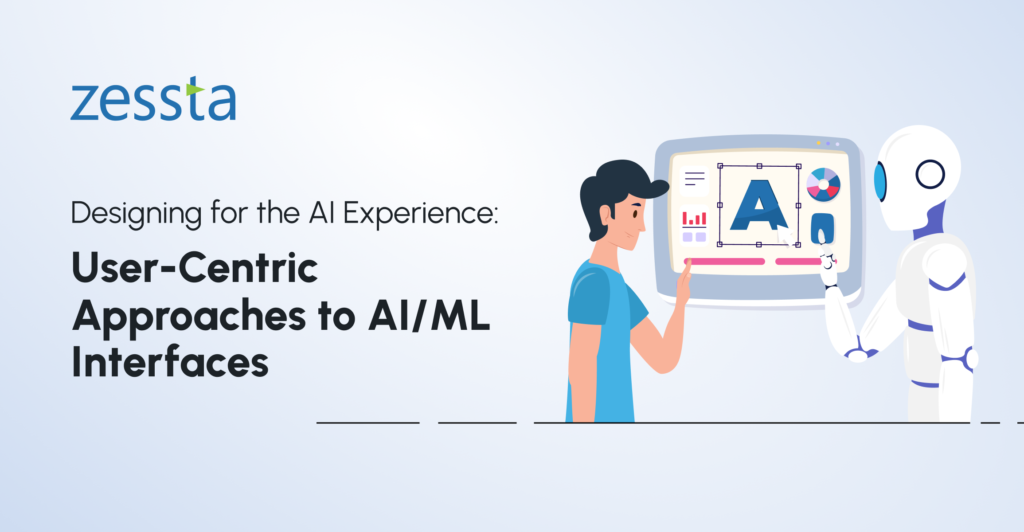Designing for the AI Experience: User-Centric Approaches to AI/ML Interfaces
Designing for the AI Experience: User-Centric Approaches to AI/ML Interfaces

In today’s design world, people are buzzing about Artificial Intelligence (AI) and it’s cool potential. If you’re new to the AI scene like me (just two years in!), you might be wondering, ‘What’s it like to design with AI? How can I make AI-friendly designs?’ Don’t worry; we’re all in the same boat.
When I started this AI journey two years ago, I had a bunch of questions too. That’s why I’m excited to share some basic tips that have helped me and my team. With these tips, you’ll get that adventurous spirit needed to work on teams building AI-powered stuff and impress your users with what you create.
Let me pin down some of the most important principles for crafting beautiful user experiences
- User-Centricity
“Putting Users First: Making AI Your Friendly Sidekick”
What it means: When you design something with AI, like an app or a website, think about the people who will use it. Make sure it helps them in a way that’s easy to understand and enjoyable.
Example: Imagine you have a virtual assistant on your phone. If it’s designed with you in mind, it can suggest helpful things like reminding you of important meetings or even recommending a new recipe based on your food preferences. It’s like having a helpful sidekick!
- Data Quality Matters
“Data: The Secret Sauce for AI Success (It’s Like Using Fresh Ingredients for a Delicious Recipe)”
What it means: Just like a chef needs fresh and high-quality ingredients to cook a delicious meal, AI needs good, accurate information to work properly. If the information going into AI is bad, the results will be bad too.
Example: Think about a weather app. If it gets its data from unreliable sources, it might tell you it’s going to be sunny when it’s actually raining outside. You don’t want your users to have a soggy picnic. Don’t you!
That’s why it’s crucial for the app to have the best data possible so you can plan your day correctly.
- Transparency
“AI Unmasked: Why It Recommends What It Does (No More Mysterious Movie Picks!)”
What it means: Imagine if your best friend recommended a movie, but they wouldn’t tell you why they thought it was great. It might be hard to trust their recommendation, right? AI should be the same. It should explain why it’s making certain suggestions or decisions so you can trust it.
Example: When you use a music streaming app like Spotify, it might suggest songs you’d like. If it tells you it’s suggesting a song because it’s similar to others you’ve enjoyed, you can understand why it made that recommendation. It’s like having a DJ who explains their song choices.
- Ethical Considerations
“Fair Play with AI: Avoiding Robot Favoritism and Keeping It Fair in the School of Life”
What it means: AI should be fair to everyone. It shouldn’t show favouritism or treat people differently based on things like their race, gender, or where they’re from. It’s like making sure everyone gets a fair shot in a game.
Example: In school, when teachers use AI to grade tests, it’s important that the AI doesn’t accidentally give higher scores to one group of students over another just because of who they are. It should grade everyone’s work fairly.
- Continuous Learning
“AI’s Never-Ending Homework: Getting Smarter and Smarter Like Your Brainy Friend”
What it means: Think of AI like a student who keeps learning and getting better at their schoolwork. AI should always be improving and getting smarter.
Example: Voice assistants like Alexa or Google Assistant learn from your questions and commands. They become better at understanding you and providing helpful answers as they learn from your interactions.
- Robust Testing
“AI Stress Tests: Because Even Robots Need a Trial Run Before the Big Show”
What it means: Before releasing something with AI, it’s like testing a new video game to make sure it works without any bugs. AI needs to go through lots of testing to make sure it can handle different situations without making mistakes.
Example: Self-driving cars are tested extensively to ensure they can drive safely in various conditions, just like how a human driver would navigate different roads and weather conditions.
- Human Oversight
“When AI Hits a Bump: Why Humans Are the Superheroes of Tech Support”
What it means: Sometimes, AI can’t handle everything on its own. It’s like having a superhero sidekick who can’t do everything alone. Humans need to step in when things get too complicated or when AI makes a mistake.
Example: If you’re using an automated customer service chatbot and it can’t solve your problem, it should connect you to a real human customer service representative who can give you the help you need.
So there you have it, the secrets of AI design unveiled! Remember, AI is like a quirky robot friend – it wants to help, but it needs your guidance. Follow these principles, and you’ll be the AI wizard in your design world!
Ready to harness the power of AI for your next big product? Let’s turn your AI dreams into reality! Contact our AI experts today for a consultation and kickstart your journey into AI-powered innovation. Don’t miss the chance to lead the AI revolution in your industry!